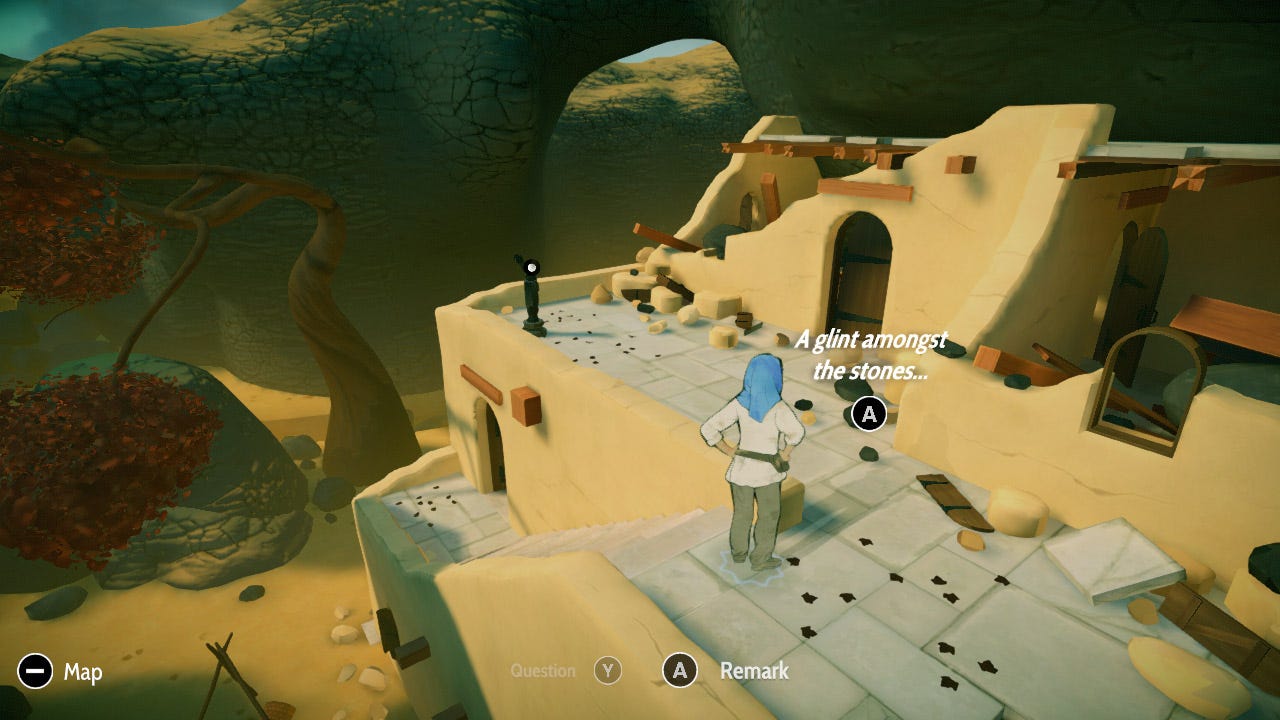Issue 4.1: Once Upon a Game
An Archaeological Analysis of Heaven's Vault, Breath of the Wild, Outer Wilds, and more!
Game & Word Volume 4, Issue 1: Sunday, Sept. 11, 2022

Publisher: Jay Rooney
Author, Graphics, Research: Jay Rooney
Logo: Jarnest Media
Founding Members:
Le_Takas, from Luzern, Switzerland (Member since April 14, 2022)
Ela F., from San Diego, CA (Member since April 24, 2022)
Alexi F., from Chicago, IL (Member since May 13, 2022)
Elvira O., from Mexico City, Mexico (Member since May 18, 2022)
Special Thanks:
Kaitlyn Kingsland of Archaeogaming and Mike Sowden of Everything Is Amazing, for tons of very helpful background information on the wonderful world of archaeology!
YOU, for reading this issue!
Table of Contents
Summary
Feature: “Once Upon a Game” (~20-minute read)
Food for Talk: Discussion Prompts
Further Reading
Game & Word-of-Mouth
Footnotes
Summary:
There’s more to archaeology than Indiana Jones, Lara Croft, and Nathan Drake! While evading traps in ancient temples (which are strangely still functional) and escaping from snake pits seems undoubtedly fun, real-life archaeological work is considerably more mundane… but no less riveting.
This is especially the case for those enterprising archaeologists who apply archaeological methods to studying video games. Even within this nascent field-within-a-field, there are so many different branches and sub-branches, from the study of games themselves as archaeological artifacts to conducting archaeological expeditions within game worlds.
And the best part? The archaeologist’s mindset is accessible to anyone curious about the digital realms they play in—even you! All you have to do is ask “how” and “why” your favorite games became the way they are.
Previous Issues:
Volume 1 (The Name of the Game): Issue 1 ● Issue 2 ● Issue 3 ● Issue 4
Volume 2 (Yo Ho Ho, It’s a Gamer’s Life for Me): Issue 1 ● Issue 2 ● Issue 3 ● Bonus 1 ● Issue 4 ● Issue 5 ● Issue 6 ● Issue 7 ● Bonus 2 ● Issue 8 ● Bonus 3
Volume 3 (Game Over Matter): Intro ● Issue 1 ● Issue 2 ● Issue 3 ● Podcast 1 ● Issue 4 ● Video Podcast 1 ● Bonus 1 ● Issue 5 ● Podcast 2 ● Issue 6 ● Issue 7 ● Issue 8 ● Issue 9 ● Podcast 3 ● Bonus 2
Volume 4 (Tempus Ludos): Intro
Game & Word is a reader-supported publication. To support my work and keep this newsletter free and available to all, consider becoming a free or paid subscriber:
Or, you could help offset my caffeine costs by chipping in for the price of a cup of joe:
Feature: Once Upon a Game
🚨🚨🚨 SPOILER ALERT 🚨🚨🚨
This post contains visual and thematic spoilers for The Forgotten City, Heaven’s Vault, No Man’s Sky, Outer Wilds, and The Legend of Zelda: Breath of the Wild. You've been warned!
Let me ask you a couple of questions: when you hear the word archaeology, or archaeologist, what comes to mind?
Chances are, the first thing that popped into your head was Indiana Jones, or perhaps—since this is a gaming newsletter—Lara Croft or Nathan Drake. But the excavations and other fieldwork that typically comes to mind actually constitute a very small (some would say minuscule) portion of the field1 of archaeology (also, IRL archaeologists don't usually dodge rolling boulders or fight Nazis while out on a dig).
Most of an archaeologist’s day-to-day work consists of research, which seems obvious enough—that’s the case with any scholar. But even when excavations are involved, the actual dig is still just a small piece of the wider puzzle. Archaeologists must set research objectives, survey potential excavation sites, grapple with logistics, and determine whether excavation is even required to achieve your objectives.
That’s right; you don’t even need to dig to find the answers you’re looking for. And since digs are both very expensive and inherently destructive,2 other methods (like, for instance, LIDAR) are usually preferable.
But even beyond that, many archaeologists specialize in complementary fields, including (but not limited to) linguistics, cartography, history, anthropology, physical sciences,3 and even philosophy. Archaeologists also specialize in specific regions and eras.
So, that’s the broader picture. But if we narrow it down to the intersection of archaeology and video games, we come upon one of the most fascinating and dynamic subfields within the discipline: archaeogaming.





